Readers of all ages who enjoy a well-crafted mystery or detective story will be interested in listening to or reading these recently published books that will draw them into the activities of amateur sleuths, detectives, and spies as they search for clues, break codes, solve crimes, and commit espionage.
Ages 4–8
King & Kayla and the Case of Found Fred (King & Kayla #5). Dori Hillestad Butler. Ill. Nancy Meyers. 2019. Peachtree.
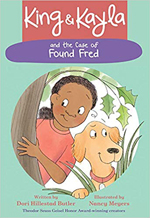 When golden retriever King and his human, Kayla, find a lost dog in Grandma’s yard near the lake, they have a new case to solve. As Kayla makes a list of everything they about the dog (no collar, follows commands, Grandma’s neighbors don’t recognize him), King learns that the dog, Fred, ran away from his people during fireworks. When Kayla, Grandma, and the two dogs search for Fred’s family along the shore from a boat, Fred jumps overboard (with King on his heels) and sniffs his way to his family in a nearby campground. Finding himself separated from his humans, King trots back for a happy reunion with Kayla and Grandma on the boat dock. Brightly colored cartoon illustrations provide young readers with visual clues to follow as the detective duo solves this missing canine case, which is humorously told from the point of view of King.
When golden retriever King and his human, Kayla, find a lost dog in Grandma’s yard near the lake, they have a new case to solve. As Kayla makes a list of everything they about the dog (no collar, follows commands, Grandma’s neighbors don’t recognize him), King learns that the dog, Fred, ran away from his people during fireworks. When Kayla, Grandma, and the two dogs search for Fred’s family along the shore from a boat, Fred jumps overboard (with King on his heels) and sniffs his way to his family in a nearby campground. Finding himself separated from his humans, King trots back for a happy reunion with Kayla and Grandma on the boat dock. Brightly colored cartoon illustrations provide young readers with visual clues to follow as the detective duo solves this missing canine case, which is humorously told from the point of view of King.
—CA
Little Fox and the Missing Moon. Ekaterina Trukhan. 2019. Random House.
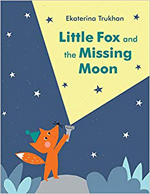 For amateur sleuth Little Fox, spring cleaning involves dusting his collection of mystery books and polishing his Detective Magnifying Glass. Awakened during the night by a bad dream about monsters eating the moon, he looks out the window and discovers that, although the stars are shining brightly, the moon is not in the sky. With friends Owl, Bear, and Wolf, Little Fox goes to Rabbit’s house to get him to join the search for the missing moon. They find him in the kitchen scrubbing the moon in a suds-filled sink. Washing the moon is one of Rabbit’s spring cleaning activities. Case solved. Ekaterina Trukhan’s digitally created graphic artwork in muted colors and inky black includes a giggle-inducing scene of the nightmare monsters peppering the moon before chomping into it and a vertical double-page spread showing the friends putting the moon back in the sky.
For amateur sleuth Little Fox, spring cleaning involves dusting his collection of mystery books and polishing his Detective Magnifying Glass. Awakened during the night by a bad dream about monsters eating the moon, he looks out the window and discovers that, although the stars are shining brightly, the moon is not in the sky. With friends Owl, Bear, and Wolf, Little Fox goes to Rabbit’s house to get him to join the search for the missing moon. They find him in the kitchen scrubbing the moon in a suds-filled sink. Washing the moon is one of Rabbit’s spring cleaning activities. Case solved. Ekaterina Trukhan’s digitally created graphic artwork in muted colors and inky black includes a giggle-inducing scene of the nightmare monsters peppering the moon before chomping into it and a vertical double-page spread showing the friends putting the moon back in the sky.
—CA
Recipe for Disaster (Didi Dodo, Future Spy #1). Tom Angleberger. Ill. Jared Chapman. 2019. Amulet/Abrams.
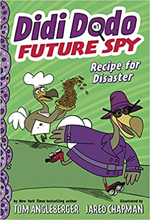 Someone has stolen baker Koko Dodo’s Super Secret Fudge Sauce, the topping he needs to put on his cookies to win the Queen’s Royal Cookie Contest being held at the mall that afternoon. Koko Dodo needs the sauce’s secret ingredient (which is so secret even he doesn’t know what it is), and the only clue is the empty jar. Not to worry. Didi Dodo, Future Spy, who has just speeded into the Cookie Shop on roller skates, has a daring plan to locate the thief and save the day. And so begins a complicated and wacky series of encounters with a host of interesting characters and daring misadventures ending with an outrageously riotous romp through the mall—and the promise of more cases to come. Short action-filled chapters and cartoon illustrations (including a comic strip and recipe cards) make this a fun-to-read first chapter book.
Someone has stolen baker Koko Dodo’s Super Secret Fudge Sauce, the topping he needs to put on his cookies to win the Queen’s Royal Cookie Contest being held at the mall that afternoon. Koko Dodo needs the sauce’s secret ingredient (which is so secret even he doesn’t know what it is), and the only clue is the empty jar. Not to worry. Didi Dodo, Future Spy, who has just speeded into the Cookie Shop on roller skates, has a daring plan to locate the thief and save the day. And so begins a complicated and wacky series of encounters with a host of interesting characters and daring misadventures ending with an outrageously riotous romp through the mall—and the promise of more cases to come. Short action-filled chapters and cartoon illustrations (including a comic strip and recipe cards) make this a fun-to-read first chapter book.
—CA
There Are No Bears in This Bakery. Julia Sarcone-Roach. 2019. Knopf/Random House.
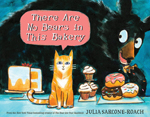 “The name is Muffin. And this is my tale.” When unfamiliar night sounds hit the alley, Muffin the cat investigates. Discovering a hungry cub in the Little Bear Bakery, Muffin is on the case (the cookie case!) helping him to the bakery goods. Then an enormous mama bear that smells like a “dumpster on a hot day” sneaks up and, after an initial staring contest, engulfs Muffin and the cub in a big, long bear hug. Together they all finish the night with a snack of sprinkles before Muffin sends the bears on their way. Exhausted by the busy night, Muffin is ready for a nap, and this cat-noir tale ends with “So that’s it. Another case closed by Muffin. No bears in Little Bear Bakery. Not anymore.” Humorous illustrations created using acrylic paint, cut paper, and markers in a palette of just-right-for-night colors bring the world of this little cat detective with a big personality to life.
“The name is Muffin. And this is my tale.” When unfamiliar night sounds hit the alley, Muffin the cat investigates. Discovering a hungry cub in the Little Bear Bakery, Muffin is on the case (the cookie case!) helping him to the bakery goods. Then an enormous mama bear that smells like a “dumpster on a hot day” sneaks up and, after an initial staring contest, engulfs Muffin and the cub in a big, long bear hug. Together they all finish the night with a snack of sprinkles before Muffin sends the bears on their way. Exhausted by the busy night, Muffin is ready for a nap, and this cat-noir tale ends with “So that’s it. Another case closed by Muffin. No bears in Little Bear Bakery. Not anymore.” Humorous illustrations created using acrylic paint, cut paper, and markers in a palette of just-right-for-night colors bring the world of this little cat detective with a big personality to life.
—NB
Ages 9–11
Kazu Jones and the Denver Dognappers (Kazu Jones #1). Shauna M. Holyoak. 2019. Disney-Hyperion.
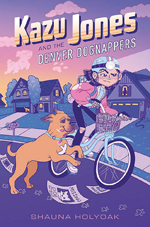 In this middle-grade series opener, 11-year-old Japanese-American Kazuko, a spunky self-proclaimed detective who lives with her parents and dog, Genki, walks dogs, delivers newspapers, and does odd jobs for a neighbor in Denver, where dognapping is occurring. While walking the neighbor’s dog, Barkley, Kazu lets him off leash. Barkley runs away, and, when she can’t find him, she suspects he has been dognapped. Within the week, classmates CindeeRae and Madeleine have their dogs stolen, and her own beloved Genki disappears. Even after the police and her mother warn her away from crime-solving activities, Kazu, March (fellow detective and tech hacker), CindeeRae, and Madeleine band together to gather clues, crack codes, and decipher notes to solve the mystery of the missing dogs—and discover more than they bargained for. A hook at the end will draw readers into the next book in the series.
In this middle-grade series opener, 11-year-old Japanese-American Kazuko, a spunky self-proclaimed detective who lives with her parents and dog, Genki, walks dogs, delivers newspapers, and does odd jobs for a neighbor in Denver, where dognapping is occurring. While walking the neighbor’s dog, Barkley, Kazu lets him off leash. Barkley runs away, and, when she can’t find him, she suspects he has been dognapped. Within the week, classmates CindeeRae and Madeleine have their dogs stolen, and her own beloved Genki disappears. Even after the police and her mother warn her away from crime-solving activities, Kazu, March (fellow detective and tech hacker), CindeeRae, and Madeleine band together to gather clues, crack codes, and decipher notes to solve the mystery of the missing dogs—and discover more than they bargained for. A hook at the end will draw readers into the next book in the series.
—NB
The Secrets of Winterhouse (Winterhouse #2). Ben Guterson. Ill. Chloe Bristol. 2019. Christy Ottaviano/Henry Holt/Macmillan.
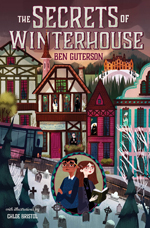 It’s Christmas, and 12-year-old Elizabeth Somers, a book lover and puzzle solver, has returned as a permanent resident to Winterhouse, the enchanting hotel owned by her grandfather Norbridge. With the help of permanent guest and inventor 12-year-old Freddy, she observes the inexplicable behavior of eccentric guests prowling and tapping on walls, deciphers the Winterhouse seal in front of Grace Hall, sleuths for secrets in the library, searches for powerful artifacts hidden by former guest Riley S. Granger, and locates concealed passageways. Pitted against the spirit of Gracella Winter (Norbridge’s deceased sister), Elizabeth must win the fight of her life if Winterhouse is to survive. Fans of paranormal mysteries who missed Winterhouse (2018), in which Elizabeth makes her first visit to the hotel, may want to check it out too. Black-and-white illustrations, charts, anagrams, riddles, and puzzles invite readers to discover the secrets of Winterhouse along with Elizabeth.
It’s Christmas, and 12-year-old Elizabeth Somers, a book lover and puzzle solver, has returned as a permanent resident to Winterhouse, the enchanting hotel owned by her grandfather Norbridge. With the help of permanent guest and inventor 12-year-old Freddy, she observes the inexplicable behavior of eccentric guests prowling and tapping on walls, deciphers the Winterhouse seal in front of Grace Hall, sleuths for secrets in the library, searches for powerful artifacts hidden by former guest Riley S. Granger, and locates concealed passageways. Pitted against the spirit of Gracella Winter (Norbridge’s deceased sister), Elizabeth must win the fight of her life if Winterhouse is to survive. Fans of paranormal mysteries who missed Winterhouse (2018), in which Elizabeth makes her first visit to the hotel, may want to check it out too. Black-and-white illustrations, charts, anagrams, riddles, and puzzles invite readers to discover the secrets of Winterhouse along with Elizabeth.
—NB
Ages 12–14
George Washington’s Secret Six: The Spies Who Saved America (Young Readers’ Edition). Brian Kilmeade & Don Yaeger. 2019. Viking/Penguin.
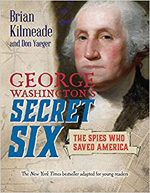 Recognizing that the small, untrained, poorly supplied Continental Army would not be able to overpower the British forces, in 1778, General George Washington directed Captain Benjamin Tallmadge to act as a spymaster on Long Island to create an intelligence network, the Culper Ring (which eventually included farmer Abraham Woodhull, longshoreman Caleb Brewster, tavern keeper Austin Roe, dry goods shopkeeper Robert Townsend, printer James Rivington, and a woman known only as Agent 355). The important role this top-secret ring of spies played in General Washington’s decision making during the American Revolution is chronicled in this accessible and engaging adaptation for young readers. Appendixes include interesting notes on the postwar lives of the Culper Ring; Washington’s time as a spy; the significance of the Culper Ring; ways of communicating in secret: use of invisible ink and alphabetical coding; a timeline; an annotated list of selected sources; and an index.
Recognizing that the small, untrained, poorly supplied Continental Army would not be able to overpower the British forces, in 1778, General George Washington directed Captain Benjamin Tallmadge to act as a spymaster on Long Island to create an intelligence network, the Culper Ring (which eventually included farmer Abraham Woodhull, longshoreman Caleb Brewster, tavern keeper Austin Roe, dry goods shopkeeper Robert Townsend, printer James Rivington, and a woman known only as Agent 355). The important role this top-secret ring of spies played in General Washington’s decision making during the American Revolution is chronicled in this accessible and engaging adaptation for young readers. Appendixes include interesting notes on the postwar lives of the Culper Ring; Washington’s time as a spy; the significance of the Culper Ring; ways of communicating in secret: use of invisible ink and alphabetical coding; a timeline; an annotated list of selected sources; and an index.
—CA
How I Became a Spy: A Mystery of WW II London. Deborah Hopkinson. 2019. Knopf/Random House.
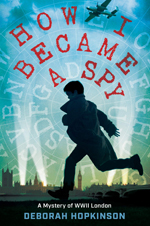 On the night of February 18, 1944, while on patrol as a London civil defense volunteer, 12-year-old Bertie Bradshaw runs into a girl with his bicycle and recovers a notebook she dropped. After learning that the journal was given to Eleanor, the American girl he hit, for safe-keeping by her French tutor, Violette, who has gone missing, and that someone else seems to be after the journal, Bertie, Eleanor, and his friend David set out to decipher its entries. In doing so, they uncover a double agent and a plot to disrupt the D-Day invasion of Normandy. Epigraphs from Sherlock Holmes’ mysteries and a Special Operations Executive’s Wartime Spy-training Manual add interest. Back matter includes ciphers to practice on; source notes; an author’s note; an interview with Deborah Hopkinson; and a roster of terms, events, and historical figures.
On the night of February 18, 1944, while on patrol as a London civil defense volunteer, 12-year-old Bertie Bradshaw runs into a girl with his bicycle and recovers a notebook she dropped. After learning that the journal was given to Eleanor, the American girl he hit, for safe-keeping by her French tutor, Violette, who has gone missing, and that someone else seems to be after the journal, Bertie, Eleanor, and his friend David set out to decipher its entries. In doing so, they uncover a double agent and a plot to disrupt the D-Day invasion of Normandy. Epigraphs from Sherlock Holmes’ mysteries and a Special Operations Executive’s Wartime Spy-training Manual add interest. Back matter includes ciphers to practice on; source notes; an author’s note; an interview with Deborah Hopkinson; and a roster of terms, events, and historical figures.
—CA
Ages 15+
The Lonely Dead. April Henry. 2019. Christy Ottaviano/Henry Holt/Macmillan.
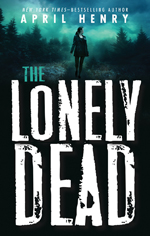 Sixteen-year-old Adele Meeker, who lives with her grandfather (her only living relative), suffers from familial schizophrenia and can see the dead when she’s not on her medications, and since she hasn’t taken them for the last two weeks, she feels more alive than she has for years. The day after a rowdy high-school party where everyone drank too much and where Adele was verbally attacked by Tori Rasmussen, her former best friend from grade school, after she caught Adele kissing her boyfriend, she finds ghost Tori leaning against a tree in Gabriel Park in last night’s outfit, tethered to her semi-buried body by a gray rope of mist. Quickly identified as a prime murder suspect, Adele must work with snarky Tori, whom no one else can see or hear and whose memory of her murder is slow in returning, to clear her name and help identify the real killer before she becomes the next victim in this paranormal thriller.
Sixteen-year-old Adele Meeker, who lives with her grandfather (her only living relative), suffers from familial schizophrenia and can see the dead when she’s not on her medications, and since she hasn’t taken them for the last two weeks, she feels more alive than she has for years. The day after a rowdy high-school party where everyone drank too much and where Adele was verbally attacked by Tori Rasmussen, her former best friend from grade school, after she caught Adele kissing her boyfriend, she finds ghost Tori leaning against a tree in Gabriel Park in last night’s outfit, tethered to her semi-buried body by a gray rope of mist. Quickly identified as a prime murder suspect, Adele must work with snarky Tori, whom no one else can see or hear and whose memory of her murder is slow in returning, to clear her name and help identify the real killer before she becomes the next victim in this paranormal thriller.
—NB
What We Buried. Kate A. Boorman. 2019. Henry Holt/Macmillan.
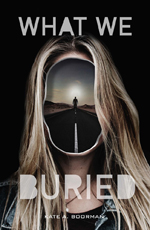 Although they despise everything about each other and their parents, 16-year-old Lavinia, a former child beauty queen suing her parents for legal emancipation because of her forced participation in a teenage reality TV show, and 18-year-old Jory, born with Moebius syndrome (partial facial paralysis) and a recluse, take off on a road trip to the family cabin in Nevada to solve the mystery of their parents’ disappearance from the courthouse on the day of Liv’s hearing. Readers quickly realize that things are not as they seem in this story told from the alternating points of view of Liv and Jory and interspersed with flashbacks to their childhoods and a pervading sense of déjà vu. This fast-paced psychological thriller builds to a surrealistic crescendo as Liv and Jory use the clues they’ve discovered and memories they’ve buried to figure out what happened to their parents, to uncover family secrets, and to deal with a final reality so duplicitous they never could have imagined it.
Although they despise everything about each other and their parents, 16-year-old Lavinia, a former child beauty queen suing her parents for legal emancipation because of her forced participation in a teenage reality TV show, and 18-year-old Jory, born with Moebius syndrome (partial facial paralysis) and a recluse, take off on a road trip to the family cabin in Nevada to solve the mystery of their parents’ disappearance from the courthouse on the day of Liv’s hearing. Readers quickly realize that things are not as they seem in this story told from the alternating points of view of Liv and Jory and interspersed with flashbacks to their childhoods and a pervading sense of déjà vu. This fast-paced psychological thriller builds to a surrealistic crescendo as Liv and Jory use the clues they’ve discovered and memories they’ve buried to figure out what happened to their parents, to uncover family secrets, and to deal with a final reality so duplicitous they never could have imagined it.
—NB
Nancy Brashear is Professor Emeritus of English, Azusa Pacific University, in Azusa, California. Carolyn Angus is former director of the George G. Stone Center for Children's Books, Claremont Graduate University, in Claremont, California.
These reviews are submitted by members of the International Literacy Association's Children's Literature and Reading Special Interest Group (CL/R SIG) and are published weekly on Literacy Daily.